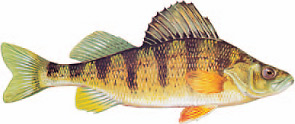 Scientific Name
Scientific Name
Perca flavescens
Other Common Names
ringed perch, raccoon perch, striped perch
Identification
Member of the perch family, which includes the walleye, sauger and numerous small darters. Generally olive-green above, fading down the sides to green or yellow- green, to yellow or golden yellow. Has eight vertical dusky bars on its side and a silvery underside. Dorsal fins have a distinctive dusky blotch. Ventral and anal fins are yellow to orange, turning a bright orange on breeding males. Average 6 to 8 inches, but commonly reach 14 to 15 inches and 1.5 to 2 lbs.
Best Fishing
Brackish-water tributaries of the Chesapeake Bay. Top waters here include Machodoc, Maddox, Aquia and Occoquan creeks. Lakes: Western Branch, Prince, Waller Mill, Little Creek, Holliday, Moomaw and Claytor. Rivers: Potomac, Rappahannock, Chickahominy, Nottoway and New.
Fishing Techniques
Ready feeders, but cautious biters and slow movers. Locate schools of fish by drift fishing or use deep jigging methods. Small minnows are the best overall bait. Other popular live baits include mummichogs, mayfly nymphs, worms and grubs. They’ll also hit fish eyes, cut bait and pork rind, as well as artificials tipped with some of the above, including small spoons, spoon hooks, spinners, bucktails, spinner baits and streamers.
Feeding Habits
Juvenile perch feed on plankton, turning to aquatic insects, then small fishes as they grow larger. Occasionally they feed on crayfish, snails and other invertebrates, and the eggs of other species.
Habitat
Found mainly in piedmont and coastal plain waters, where they thrive in tidal rivers and streams, extending into brackish water. Also common in many reservoirs. They locate in pools and backwaters where they school along shallow vegetated areas during warmer months.
Spawning Habits
Run in schools up tributaries to spawn in late will aerate eggs. No nest is built, and the females release eggs in long gelatinous “ribbons” or “streamers” which are fertilized by the males as they are released. Spawning activity takes place at night. February or early March when water temperatures reach 45° to 50°F. Also seeks out shallow shoals in lakes where water movement


